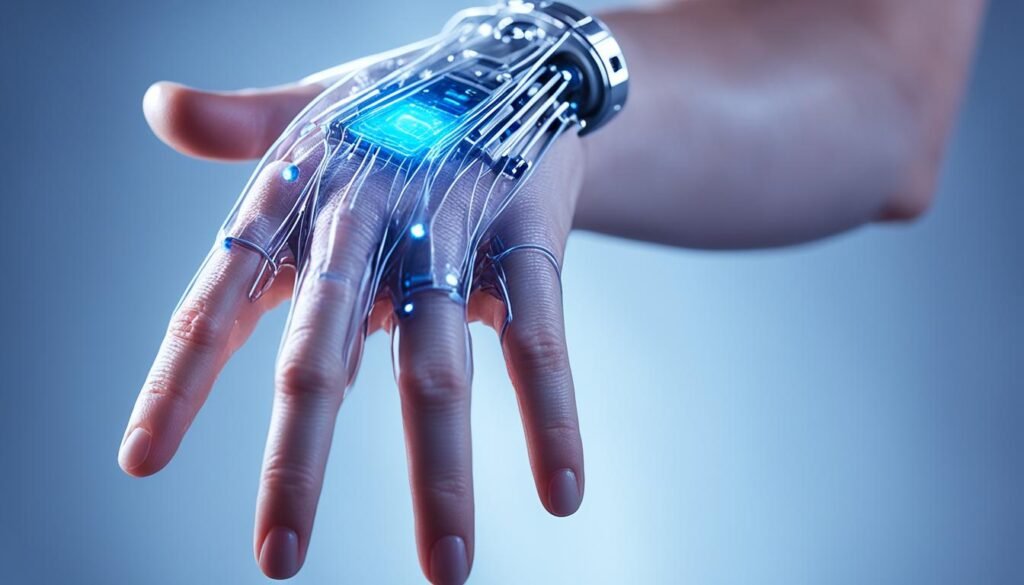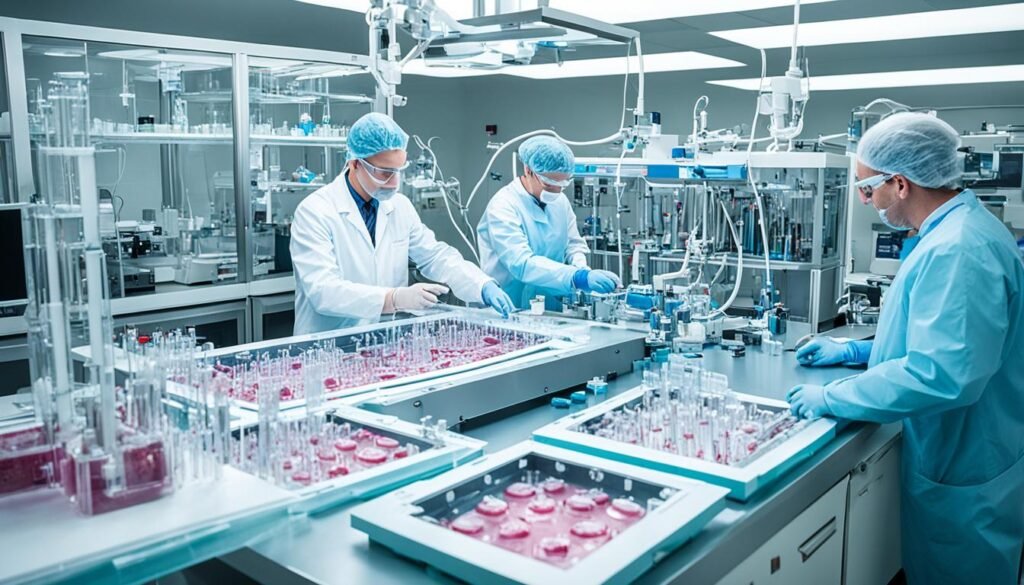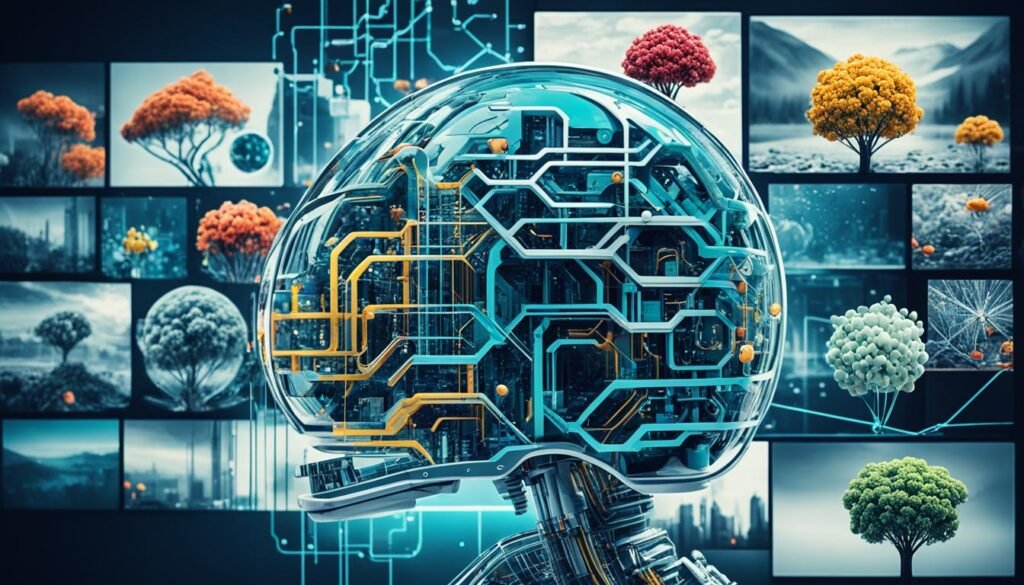Technology moves at a fast pace in our world today. It feels like every day there are new technologies and innovations that could change everything. Artificial intelligence now writes poems and creates pictures from words. You can find 3D-printed eyes, holograms, and even food grown in labs. Also, there are robots that read our minds. This is only the beginning of what’s possible.
This quick pace of technological advancement comes from many new technologies. These technologies are ready to change how we do things, make life better, and solve big global problems. Think of quantum computing, autonomous vehicles, biotechnology, and renewable energy. The future of technology looks bright with many chances to change our world in the next few years and beyond.
Key Takeaways
- The future of technology is being shaped by a diverse array of cutting-edge innovations across industries.
- Artificial intelligence, quantum computing, and sustainable technologies are among the key drivers of technological transformation.
- Emerging technologies like autonomous vehicles, biotechnology, and edge computing are poised to disrupt and enhance various sectors.
- The rapid pace of technological change is transforming how we live, work, and interact with the world around us.
- Keeping up with the latest tech trends and innovations is crucial for businesses and individuals to stay competitive and responsive to evolving needs.
Necrobotic Technology
New future technologies can bring about big changes. They can be amazing, but also a bit creepy. Necrobotics is a good example. This field is about turning dead beings into robots. It sounds like something from a scary movie. But, it’s a real study at Rice University.
Turning Dead Spiders into Robotic Grippers
Rice University’s team has made a dead spider into a gripper that can pick things up. They fill the spider with air to do this. Spiders use hydraulics to make their legs move. This is how they can crawl and jump.
Using Hydraulics to Extend Spider Limbs
The researchers are using the spiders’ own tricks to help create robotic helpers. This necrobotic work is just starting. But, one day it might help us in ways that now seem like a horror story. It’s like the story of Frankeinstein coming to life.
Potential Applications in Science
This technology has many possible uses, from special tools to new kinds of robots. Rice University is leading the way. They are testing how far this technology can go. We might see some amazing and odd uses for this in the future.
Sand Battery Technology

A team of Finnish engineers tackled a big problem in a simple way. They found a method to turn sand into a major energy storage system. It’s a breakthrough that could lead the change in our future without fancy technologies.
They packed 100 tons of sand in a big steel box. Then, they used renewable energy like wind and sun to warm it up. This created a way to store heat. Now, a local energy company can use this sand to warm up buildings. It is like storing energy in a big sandbox for later use.
Resistive Heating for Energy Storage
The heart of this new sand battery is a method called resistive heating. Sand or other non-conducting materials get warm when an electric current flows through them. This heat energy can then be saved and used.
The Finnish team’s use of resistive heating is both simple and smart. It offers a great new way to store energy. This could help change how we use renewable energy. It’s a big step in the journey towards better technology and renewable energy, not just in Finland but everywhere.
Soft E-Skin for Long-Distance Touch

Today’s technology allows us to talk and see each other from far away. But, we can’t share the sense of touch over long distances. Yet, a team from the City University of Hong Kong has designed a soft e-skin that may change this. It could let us send hugs over the internet.
This e-skin uses special parts called flexible actuators. They feel the person wearing it and turn that into electrical messages. With Bluetooth, these messages reach another e-skin system. The actuators there copy the movements, allowing friends and family to ‘feel’ each other from far away.
By using this new haptic technology, we might start feeling touch from a distance. It could change the way we connect through touch. This new approach could blend the real world with the digital one.
VR Olfactory Systems
The world of virtual reality (VR) is changing. Researchers at the City University of Hong Kong (CityU) have made a new kind of VR tech. It’s a “novel, wireless, skin-interfaced olfactory feedback system.” This means they’ve made a way for VR to let you smell things in the virtual world.
Wearable Devices for Smell Simulation
These new tech devices work by melting odorous wax to make smells. They can make different smells stronger or weaker. There’s a device that goes on your upper lip and one that looks like a facemask. The facemask has lots of different smells it can create.
Applications in Teaching and Entertainment
The CityU researchers think their new tech could be used in lots of ways. They mention teaching and watching movies in 4D as examples. Just imagine being in a VR movie where you can see, hear, and even smell everything. This kind of experience would be totally new.
This new tech mixes smell, VR, and tech together. It could change how we use and enjoy virtual reality. It could affect teaching and entertainment and even more. The future of this kind of innovation sounds very interesting.
SpinLaunch for Satellite Deployment

Did you know the upcoming way to launch satellites isn’t a rocket? It’s a lot like a catapult, but way more advanced. SpinLaunch is a new tech that throws satellites into space. It uses kinetic energy rather than the fuel that traditional rockets use.
Using Kinetic Energy Instead of Rockets
This system might whip payloads to 8,000km/h and 10,000G. Then, it launches them through a big, open tube. Payloads need tiny rocket engines to get to space orbit. Yet, SpinLaunch says its method could reduce fuel and infrastructure needs by 70 percent.
Reducing Infrastructure and Fuel Costs
SpinLaunch has a deal with NASA and is testing its technology. This tech could change how we send satellites to space. By using kinetic energy over usual rocket power, the goal is to save a lot of money. This means easier and cheaper ways to explore space with new technology in the future.
Xenotransplantation for Organ Transplants

Putting a pig’s heart in a human might seem strange. Yet, it’s a new approach that’s making fast progress. Xenotransplantation involves using animal cells, tissues, or organs in people. This could completely change how surgeries are done. A pig’s heart has been put into humans twice. The first patient lived only a few months. The second’s story is still unfolding.
Gene-Editing Animal Organs for Humans
In xenotransplant surgeries, we can’t just switch the organ over at once. Gene-editing has to happen. We remove certain animal genes and add some human ones. This mainly helps with making the body accept the new organ and stop it from growing too much. These surgeries are still quite risky, and we can’t expect them to work every time.
Potential to Revolutionize Surgery
Someday soon, xenotransplants might become a common way to help sick people. They could offer new hearts or tissues from animals to humans desperately needing them. This medical technology holds a great promise to change surgery forever. It gives hope and new chances to those requiring organ transplants.
Future Of Technology

As artificial intelligence gets better, it’s not just in jobs, but now it’s moving into art. The company OpenAI made a software that makes images from words. For example, you can say ‘a dog wearing a cowboy hat singing in the rain’. It’ll show you many different pictures of that happening.
This tech, called Dall-E, is on its second version. The team plans to make it even better. But, it’s not perfect yet. It sometimes messes up when we ask for special things, like designing cartoons.
AI Image Generation from Text Prompts
Because of this AI, we might get to see totally new things, like art shows that feature work made by computers. Or, companies could quickly get cool pictures for their needs. And let’s not forget how it could change making memes. For instance, Midjourney can create dark and interesting artworks with just some written ideas.
Applications in Art and Meme Creation
AI and image generation are ready to shake up art and meme making. They are making it simple to dream up and create new, wild ideas. With technologies like OpenAI’s Dall-E and Midjourney, we will get to explore many new ways to express what’s in our imagination.
Brain-Computer Interfaces

The brain-computer interface (BCI) tech is not just for movies anymore. Its use has grown a lot lately. In Switzerland, at the Swiss Federal Institute of Technology Lausanne (EPFL), some exciting tests are happening.
Controlling Robotic Arms with Brain Signals
A special algorithm works with a robot arm and a BCI. It helps tetraplegic patients communicate with the world. During tests, a robot arm completed simple tasks like avoiding an obstacle. The algorithm paired with the EEG cap read brain signals. It made sure the arm moved correctly according to what the brain wanted.
This setup ultimately learns the patient’s unique brain patterns and preferences.
Assisting Tetraplegic Patients
One day, this tech might help in controlling wheelchairs or assisting tetraplegic patients. It could give them back some independence. The mix of BCI, robotics, and learning machines could make big positive changes for disabled people.
3D Printed Bones

3D printing is changing the way we see technology. It’s now possible to create bone implants specifically for patients. Ossiform leads the way in making 3D printed bones for surgery. They use a material that acts like real human bone.
Patient-Specific Bone Implants
Creating a bone for a patient is easy with 3D printing. First, the patient gets an MRI scan at the hospital. Then, this scan is sent to Ossiform. At Ossiform, experts turn this data into a 3D model of the bone the patient needs. After the surgeon checks and approves the model, the bone is printed. It’s then ready for the surgery.
Enabling Full Restoration of Function
The special thing about these 3D printed bones is the material used. It’s called tricalcium phosphate. This material makes it possible for the body to turn the bone implant into living bone. The goal is to get the implant to work just like the original bone. For this to happen, the bone is designed with lots of tiny holes and canals. These help the bone cells attach and grow, forming new bone.
Also Read: What Are The Benefits Of Smart Home Technology Applications?
Conclusion
The future of technology is on the brink of major change. We’ve seen everything from creepy yet intriguing necrobotics to new sand battery tech. These examples show how rapid innovation is.
We now have e-skins that let us feel touch from far away, VR smell systems, and brain-computer links. These techs bring the real and digital worlds together. They change how we sense our surroundings and interact with them. Besides, SpinLaunch and 3D-printed bones are pushing the limits of what we can do.
In the end, the tech we talked about points to an amazing future. It suggests we’re moving towards things we once thought were just in stories. These changes could make life better and change whole industries. But, it’s important we think about the right way to use and introduce these big tech changes.
FAQs
Q: What are the key technology trends driving the future of tech in 2024?
A: The key technology trends driving the future of tech in 2024 include quantum computing, edge computing, machine learning, augmented reality (AR), autonomous vehicles, blockchain, cybersecurity, and sustainable technologies.
Q: How is cybersecurity evolving to address emerging threats in the tech industry?
A: Cybersecurity is evolving by adopting advanced measures such as AI and machine learning for threat detection, implementing zero-trust security models, and enhancing defenses against ransomware and phishing attacks.
Q: What role does augmented reality (AR) play in transforming real-world experiences through technology?
A: Augmented reality (AR) enhances real-world experiences by overlaying digital information onto the physical environment, enabling immersive interactions in areas like gaming, education, healthcare, and retail.
Q: How is quantum computing revolutionizing traditional computing methods?
A: Quantum computing leverages the principles of quantum mechanics to perform complex calculations at speeds unattainable by classical computers, offering solutions to challenges in fields such as cryptography, drug discovery, and climate modeling.
Q: What impact do disruptive technologies have on industries like healthcare, agriculture, and supply chains?
A: Disruptive technologies drive innovation in healthcare through personalized treatments, optimize agricultural practices with precision farming techniques, and enhance supply chains with real-time tracking and predictive analytics.
Q: How are businesses leveraging synthetic data and AI to improve decision-making processes?
A: Businesses use synthetic data to train AI models, simulate scenarios, and generate insights for informed decision-making, enabling them to predict consumer behavior, optimize operations, and mitigate risks.
Q: What are the benefits of integrating robotics and automation in industries like manufacturing and logistics?
A: Integrating robotics and automation in industries improves efficiency, reduces human errors, enhances safety, increases productivity, and enables 24/7 operations, leading to cost savings and streamlined processes.
Source Links
- https://www.mckinsey.com/capabilities/mckinsey-digital/our-insights/tech-at-the-edge-trends-reshaping-the-future-of-it-and-business
- https://www.sciencefocus.com/future-technology/future-technology-22-ideas-about-to-change-our-world
- https://www.weforum.org/agenda/2022/05/17-ways-technology-could-change-the-world-by-2027/




